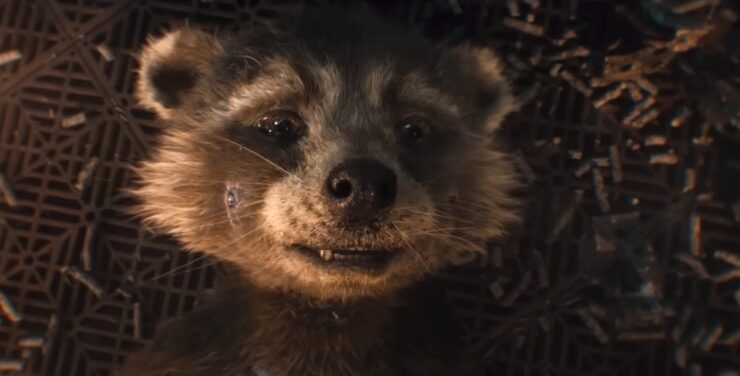The 2011 X-Men franchise prequel, X-Men: First Class, briefly featured a mutant named Darwin who could adapt to any circumstances. For example, when he stuck his head in a fish tank he grew gills. Now if you’re a history of science nerd like me, you both appreciate the Darwinian reference and wish that the movie had instead named the character Lamarck, who theorized that individual animals could adapt to environments and experience physical changes during their lives—but that doesn’t have quite the same ring to it. Darwin, on the other hand, believed that species changed through heredity and over many generations.
While in this case the slippage between evolutionary theorists and their ideas is harmless, there is a long tradition of misusing Darwin’s theory of evolution through natural selection to explain and justify concepts that are not scientific but are actually actively harmful. The creation and deployment of the term “social Darwinism” is one, and the development of the pseudoscience of eugenics in the late nineteenth century is another. Eugenics took concepts rooted in Darwin’s evolutionary theory and used them to justify different kinds of social and institutional violence against people not deemed “fit” to reproduce.
Guardians of the Galaxy Vol. 3 stages a similar mislabeling. The movie’s villain, The High Evolutionary, should more accurately be called “The High Eugenicist.”
Evolution is a random, undirected process that is not working towards any end goal other than survival. Eugenics is the attempt to “perfect” the human species—or in the case of science fiction, a sapient population—through breeding for “desirable” characteristics.
And the High Evolutionary does not mince words. He explains his eugenic project explicitly to Rocket: “We have but a single quest. To create the perfect species and the perfect society.”
To this end, he has developed high-tech chambers that will transform a non-human animal. The High Evolutionary describes the process as the ability to “guide any organism through millions of years of programmed evolutionary changes in a moment.” Although the High Evolutionary, as his choice of name suggests, couches his designs in the language of evolution, what he is describing is actually eugenics. And, in the quest for perfection, flaws justify extermination.
The essential problem with eugenics is that some people take upon themselves the privilege of deciding who is fit, to live and to reproduce, and who is not. In the Anglo-American history of eugenics in the late nineteenth through the mid-twentieth century those choices have not gone well for women, people of color, the mentally ill, and the disabled. And government sanctioned sterilization of women without their consent, or even their knowledge, has continued into the 21st century.
We can, hopefully, all agree that eugenics is bad and the High Evolutionary is pretty obviously a bad guy. And he gets his comeuppance at the end of the film. But this easy slippage between evolution and eugenics perpetuates a disturbing contemporary trend of engaging with eugenics without naming it.
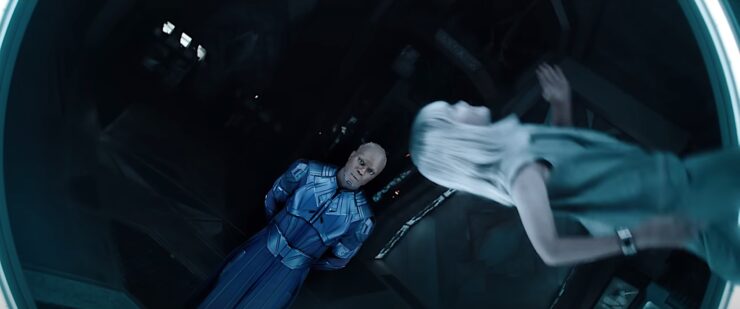
American culture is shaped by eugenic systems of measuring people and assessing their relative value. Prominent examples include the quantification and testing of intelligence through the intelligence quotient (IQ); use of the body mass index (BMI) to assess the health of individuals; and the SAT. From the vantage point of 2023, all of these have been rightfully criticized and are in the process of losing some of their power, but they are still widespread ways of judging individuals’ worth in comparison to others. Even things that we can generally agree are of huge value can be rooted in eugenics—the history of modern contraception has been intertwined with eugenic goals and legacies.
In addition to the “old eugenics” policies like sterilization, the development of genetic technology is shadowed by “new eugenics”: the desire to “improve” individuals through genetic and reproductive technology. While this includes beneficial interventions, like eliminating diseases, including sickle cell anemia, it includes more controversial possibilities, like eliminating deafness, which would also destroy a culture. While most of us agree that people should have access to IVF to address infertility and genetic diseases, there’s convincing evidence that widespread IVF usage would lead to a disproportionate number of male offspring. As genetic technology is currently developing at an astonishing rate, the potential harm of new eugenic practices is significant and under-appreciated. If we cannot label eugenics for what it is, if we don’t know its history, if we let such actions fall under the category of “nature” or “evolution” or “progress” then we are complicit. If we decide to let parents choose their children’s genetic traits—a possibility imagined to its fullest extent in the 1997 movie Gattaca —then we need to be willing to admit that there are traits that we are not choosing, and that our choices are products of cultural context and are often grounded in bias.
Science fiction, whether it’s a novel or a superhero movie, is the place our culture has turned to again and again to dramatize these concerns. Although the High Evolutionary’s bioengineering reflects our current anxieties around developments in genetic engineering, his mad scientist roots are firmly grounded in a classic science fiction literary genealogy concerned with the power of man over the creation of life. Frankenstein (1818) by Mary Shelley persists as perhaps the primary frame narrative through which we make sense of advances in technology that enhance our power over reproduction. In the novel, Victor Frankenstein discovers the secret of life and animates a body he has created by combining parts from different corpses. Once the creature is alive, Victor is so repulsed by its ugliness that he denies his offspring and refuses to play the role of father. The tragedies that follow are rooted in this neglect.
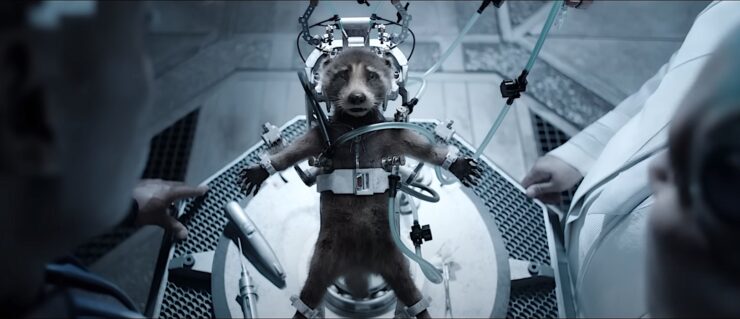
The High Evolutionary is clearly a descendant of Frankenstein: the man who thought he could play the role of god only to create a “monster.” Like Frankenstein, the High Evolutionary ultimately rejects Rocket as a creature assembled out of parts—“you look like you were cobbled together by fat-fingered children”—and resorts to language of the monstrous to abuse Rocket, shouting: “You are an abomination! [… a] freakish little monster!”
The High Evolutionary, amazingly, demonstrates more hubris than Victor Frankenstein—at least Frankenstein refuses to create an entire population. The High Evolutionary repeatedly claims that his provenance as creator gives him the right to be destroyer as well. He threatens the High Priestess of the Sovereign after Adam’s initial failure to retrieve Rocket with “I will destroy your entire civilization, as is my right as your maker.” We see him destroy a planet and a civilization, and are told that he has done this many times. While Frankenstein is accused by many readers of attempting to become god, he does so in an almost clumsy and naive way, without thinking about the consequence of this action. The High Evolutionary, on the other hand, claims his status as divine, saying: “There is no God! That’s why I stepped in!” However, this marks the moment when he begins to lose the loyalty of his employees. They see the High Evolutionary as another life form, like themselves, and his ultimate disintegration over the course of the climax undermines his claims to superiority.
The High Evolutionary is perhaps most similar to H.G. Wells’ eponymous mad scientist from The Island of Dr. Moreau (1896).
On his island, Moreau engages in grotesque and pain-filled experiments attempting to transform animals into humans. His creations are monstrous creatures capable of speech but still “bestial” in nature. Written as a response to the vivisection debates—concerns in late Victorian England over whether experiments should be performed on live animals—Moreau represents a fear that a disregard for animal pain in the pursuit of knowledge covers an evil heart that sees humans as animal, justifying brutality towards other men.
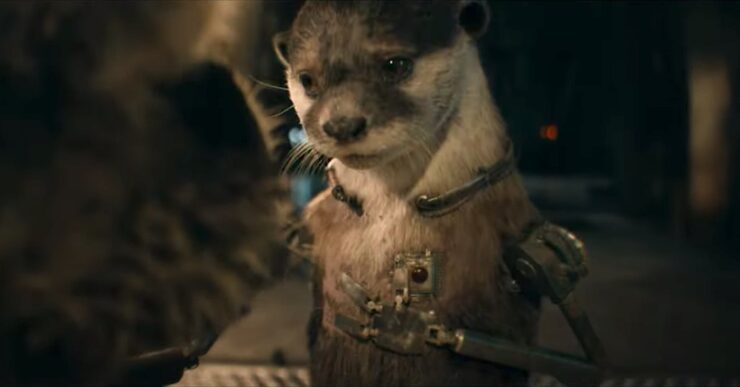
The appearance of Rocket’s friends, who later name themselves Lylla, Teefs, and Floor, immediately brings to mind H.G. Wells’ Dr. Moreau. While Moreau experiments only through organic manipulation, the mechanical additions to the four animals match the monstrous, augmented hybridity of his creations. Echoing the theme of pain, the first word that baby Rocket speaks is “hurts.” The High Evolutionary’s creation of Rocket’s cohort reflects our 21st century anxieties about the thin line between animal and human and animal and machine: a line that seems permeable with our current technology.
On our last stop through classic science fiction, the scene that reveals the children in the bowels of the ship suggests the mass production of human beings through cloning that Aldous Huxley imagined in his 1932 novel Brave New World.
This connection is strengthened by the fact that the High Evolutionary has designed this species not just to populate a planet and to be his children, but for a specific function. The first bioengineered child we see is running on a large hamster wheel—their movements repetitive and unchanging as they circle—and giggling the whole time as if they’re playing a fun game. When the High Evolutionary lists this species’ positive attributes, they include the ability to survive on thirty calories a day and one hour of sleep a week, a consistent state of happiness, and the ability to rewire a carbenetrix core in under two minutes. This species has been created for efficiency, stability, and mechanical reproduction, just like the clones of the Brave New World. In addition, their uniformity is emphasized by their matching clothes, haircuts, and facial markings, even if they may differ in size, gender, or skin color. Like Mustapha Mond and the World State, the High Evolutionary claims to be motivated by the altruistic objective of creating a utopian society. But rather than changing society, they start by attempting to create the “perfect” people.
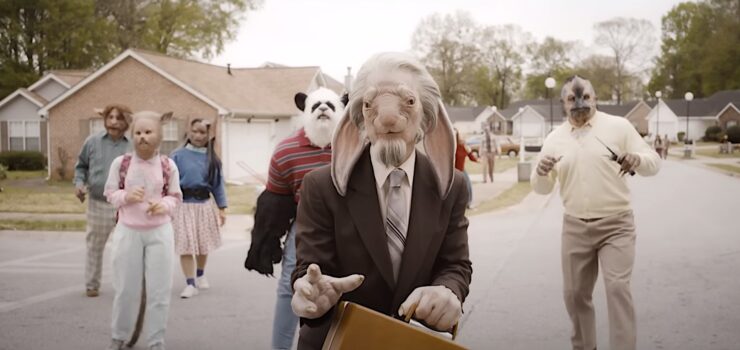
The uniformity that is central to Huxley’s dystopia is also reflected in the aesthetic of Counter-Earth. This “utopia” is based on nostalgic mid-century Americana, represented by cookie cutter suburban houses and chintzy decor. Although the actual inhabitants of this world are created from non-human animals from earth, the particular homogeneity of the landscape signals whiteness. The scene could be taken from any of the numerous domestic sitcoms that—although there are well-known exceptions—are dominated by white families. And these pop culture representations duplicate the real world practice of systemic discrimination against people of color in housing in the US. In Brave New World and the practice of eugenics more generally—which was grounded in scientific racism—whiteness is the “standard,” desirable trait.
While we can trace his ancestry through science fiction novels, the presence of the High Evolutionary and his eugenic goal to create a perfect species also situates the movie within a larger MCU genealogy of eugenic villains.
In the first volume of the Guardians trilogy (2014), Ronan wants to destroy the Xandarian species, and in Vol. 2 (2017) Ego wants to terraform planets, destroying their native life forms to propagate endless extensions of himself. Moving into the wider universe, Avengers: Age of Ultron (2015) is another Frankenstein story, with Tony Stark as the prideful creator and Ultron as the disaffected, monstrous child. Ultron believes that extinguishing human life is the only way to bring world peace. Similarly, Thanos plans to solve the problem of limited resources by annihilating half the sapient life in the galaxy.
While the evil plans are not explicitly about perfecting any species, genocide is always eugenic: it claims that some do not have the right to life, to reproduction, to continuation.
We can see that the MCU returns again and again to evil villains driven by eugenic principles. (And this is even without considering any of the X-Men movies where the theme is built into the very fabric of the universe.) This makes sense, given that much of the conflict in the MCU and several of the main superheroes and villains are grounded in the legacy of World War II. But our contemporary preoccupation is driven not by the old eugenics of the Nazis or late nineteenth century scientists like Francis Galton, but the omnipresence of the new eugenics lurking behind our justifiable human curiosity about the mechanisms of life.
While the High Evolutionary is a fitting villain, the plot of the third Guardians movie is a logical endpoint of the series’ preoccupation with hybridity and exploration of what makes a person. This is enabled by the ensemble of misfits logic that grounds the series, as opposed to the assembly of superheroes that we see in the Avengers core group.
At the end of the first Guardians movie, it’s revealed that Quill managed to save the day, not just because his friends fought with him, but because he is not fully human. The second movie is built around Quill discovering and coming to terms with his hybrid heritage. And in the holiday special, we discover that Mantis is also one of Ego’s children, so she too is a hybrid.
Meanwhile, as a cyborg, Nebula is a quintessential hybrid of science fiction: a meld between human, or humanoid alien, and machine. Nebula evolves over the course of the series (and the later Avengers movies) from Thanos’ loyal bloodhound to a full-fledged member of the Guardians, taking over Gamora’s role in a way that is explicitly acknowledged in Vol. 3. Her hybridity is a legacy of pain and torture, and Thanos manipulates it in Avengers: Endgame (2019) when he connects her past and future selves to discover the Avengers’ plans. But in Vol. 3 we see that Nebula’s hybridity is her strength making her, physically at least, the most effective of the Guardians. Visceral moments throughout the movie—where her limbs are bent and snap back into place—emphasize both her hybridity and her strength. At the end of the movie she transcends her status as weapon to become a leader. Although it is implicit, it is obvious that Nebula and Rocket share a deep connection. Both are bioengineered, both have been tortured to become who they are. Lylla the Otter’s mechanical arms visually connect her to Nebula’s multi-tool cyborg arm, which we learn that Rocket upgraded for her.
It’s also easy to forget that, for most of the series, the individuals we’re seeing on the screen are aliens, not humans, although most of them are sufficiently humanoid to be granted human status without much thought from the audience. However, in the third movie, our attention is drawn to the division between us and them through the use of non-human animals and, ultimately, sapient beings based on non-human animal forms. When Nebula explains the situation to Quill at the end of the movie she says, “There are thousands of creatures on the ship.” Which Mantis follows with “And many of them are children.” While we as viewers may comfortably assign humanity to the aliens of the movie, this moment reminds us that we are identifying a bond beyond species. It’s fitting that two of the non-human heroes would use such language.
Towards the end of the climax of the movie, Rocket tells the humanoid members of the Guardians to “save all the higher lifeforms.”
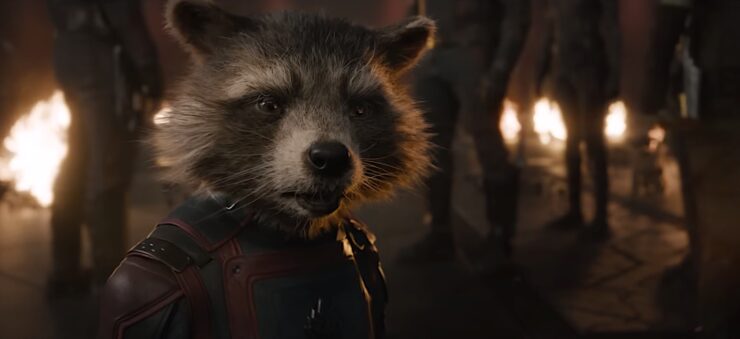
At this point, Rocket is still accepting the human/animal hierarchy. The hierarchy exists, and it means that some lives on the ship are worth saving more than others. Although he is a hybrid, he views himself primarily as a higher-level life form. We can see this in his consistent refusal that he is not a raccoon. This language returns us to the language of evolution that permeates the film. In this case “higher order” refers to a human-imposed hierarchy on what makes one animal “better” than another. However, when Rocket confronts the spectacle of the non-human animals in the ship’s hold, he rejects this binary and this hierarchy through identification with the baby raccoons. This leads him to confront Quill and say “We have to save them.” Quill responds, “We’ve got all the kids on board.” “No, Pete, the rest of them,” explains Rocket.
As we see the menagerie galloping at full speed from the ship onto Knowhere, one of the citizens remarks to Quill, “Thought we were limiting ourselves to the higher life forms.” Quill responds with an ambiguous, “Well, me too.” It would be great for the purposes of this essay if Quill had responded with a snarky cut about the value of non-human animal life or a sarcastic remark about the supposed “superiority” of humans. But even the ambiguity within Quill’s actual response suggests a rejection of the hierarchy.
The High Evolutionary must, of course, be destroyed, but the real triumph of the heroes over evil in this movie is a rejection, even an undoing, of the High Evolutionary’s ideology. In this sense, Mantis’s connection with the Abilisks is the beginning of the end. Her recognition that non-human animals have feelings and the importance of demonstrating empathy towards them undermines the hierarchies and value judgements that guide the High Evolutionary’s projects. It is a rejection of the mad scientist logic established as early as Dr. Moreau.
This rejection of hierarchy—with “perfect” at the top—and the ability to empathize with non-human animals and extend them dignity and recognition of their right to life, is what makes the good guys good.
The Guardians defeat the High Evolutionary by refusing to reinscribe the hierarchies that he creates and sustains: by refusing the eugenic logic that some lives are better and some lives are not worth living. As audience members, our ability to recognize that what the High Evolutionary does is wrong makes us feel good about ourselves. We, too, are the good guys. But in reality, uncritical acceptance of eugenic systems and new eugenic practices align us with him, not the Guardians. We may be watching “just” a superhero movie, but our awareness of the history of eugenics and the dark side of genetic technology is part of the High Evolutionary’s defeat.
Leigha McReynolds is a science fiction researcher focusing on disability, eugenics, and genetics in literature and on screen. She has published chapters in Disability in Science Fiction and Dune for the 21st Century, and you can find her work online at Ancillary Review and SFRA Review. Currently she is an Assistant Clinical Professor at the University of Maryland, and she offers classes for the local DC bookstore Politics & Prose. Find her on Twitter (@LeighaMcR).










